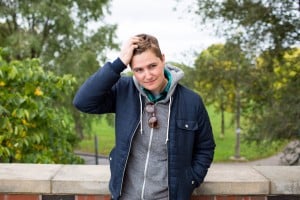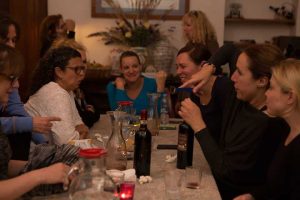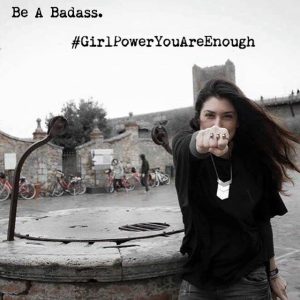By Sarah Meyer
As a kid I conceived of birth marks literally: bruises on the little body applied in the course of birth that remained forever. To this end for many years I thought the birthmark on my left shin was a bruise that, were others to touch it, would hurt extremely. Others did touch it, because I was always showing it to people. And when they touched it I would recoil in a pain that felt real but technically was not.
Yesterday a mentally ill woman tried to trip me in front of an oncoming train. I did trip, but fell the other way, toward the platform wall instead of toward the tracks. Had I fallen differently I would of course not now be writing these words.
My birthmark, I like to say, is in the shape of a heart. Although anything can be in the shape of a heart if you want it to be. When my sister and I bathed together as children she memorized it. Years later, she mentions knowing my birthmark is on my left shin because it was always on her right side when we were in the bath, sitting across from each other sharing toys.
I’m thinking now of Achilles, of his one point of vulnerability, where his mother pinched him as she held his baby body over the river Styx. I think of us in the bath water, my birthmark between us, and Achilles rises to the surface. I am thinking how my birthmark used to feel like that kind of singular vulnerable space, how now my entire body feels like such a space, how it might be nice to feel like my vulnerability were reduced to a one-inch diameter, how despite how it felt to me then, that was never near true.
After the woman tripped me, I fell toward the wall and held onto it. The tiles are white and smooth. I looked at her, and in my shock the only thing that came out of my mouth was the word what. “What?” I asked her, and held onto tiles on a wall that are wide and flat and difficult to grasp. We made eye contact, and she stuck her tongue out at me and fled. Her tongue was knotty and fat, and it has come to mind in the hours since this happened, the tongue alone. I could feel the spot on my left shin where she’d struck me for hours afterward even though she left no bruise or cut skin. I just knew where she’d struck me, on the left shin on or near my birthmark, and it rang out to remind me of something the rest of the day.
As a child I was often confused about how some babies managed not to become marked during their birth. How did some of us exit the birth canal, touching the sides of it, of our mothers, and leave with a bruise when others could do this same thing and not be marked?
Recently, in part because of violent events in the news, I had the realization that I had switched over to another side: that there had once been a time when I thought a mass shooting could not happen to me, that I could not be victim to a stranger’s act of violence, but that something had happened and now I didn’t think that anymore. I now know, not just intellectually but in my body, that it could happen to me. I live in a big city, I ride the train, I go to a gym, I enter and exit buildings that contain other people. I exist. And because I exist, it could happen to me. Then I found the Tumblr “Last Message Received”, which collects screenshots of the last messages people have received from loved ones, and that realization was somehow made permanent. Yes, I am on this side now. I wonder which messages from my friends might be their last. I wonder which of mine will be mine.
The Governor of Illinois, Bruce Rauner, has decided to address the state budget deficit in part by cutting services for the mentally ill by more than $87 million. It’s notable how separate we are able to convince ourselves other people are from us, when the reality of course is that help offered to someone like the woman who tripped me would also constitute help offered to someone like me, her bystander. Of course you are her bystander, too. Of course she is a number of people in the world, and essentially not very different from any of us.
After she ran away and I was in shock, I just got on the train and went downtown. When I sat down I started to cry, and I sat there crying until the train arrived at my stop.
Later that evening I returned to my original stop and told the turnstile operators what had happened. “You should’ve told us earlier,” they said. “Not much we can do now.” Can’t you rewind the security tape and disburse an image of her to other stations in case she does this kind of thing a lot? I asked. “Nah, the tape isn’t recording,” they said. “You would’ve had to come up here right when it happened so we could’ve called the police and tried to catch her.” At one point, in an attempt to help me understand, the operator tried to explain this to me from the point of view of the police: “They’ll find you questionable, that you didn’t come forward sooner you know? Like why did you wait so long to say anything?” I was in shock, I said. Wouldn’t they understand that? “Yeah, but like why didn’t you call on your lunch break, you know?” They told me I could call CTA to report the incident, or the police if I felt like it, and they repeated several times the phone number for the CTA helpdesk, 1-800-YOUR-CTA. 1-800-MY-CTA? I asked. No, 1-800-YOUR. I thanked them for help I did not really believe I’d been given, walked upstairs and dialed 1-800-YOUR. It was a phone sex hotline. The real number is 1-888-YOUR.
In Gavin de Becker’s The Gift Of Fear, a book I recommend to people all the time and in this way is also a kind of litmus test for how much whomever I’m talking to is willing to put up with, he writes that we are all “experts at predicting violent behavior,” that if we could listen better to our intuition we would be better able to protect ourselves from harm. I told few people about what had happened to me the day it happened, because I didn’t think I could deal with anyone getting upset. But to the people I did tell I said, “I didn’t even know she was there,” or, “She came out of nowhere.”
Hours later, lying alone on my bed with the lights on, I realized that wasn’t true. I had noticed she was there when I came down the stairs; I saw her red jacket in my periphery, heard the train coming, and did the kind of mental calculation that flutters so lightly across the mind as to not register as a thought: I have enough time to walk by this person before the train comes. Which means not only did I see her there but I logged her as some kind of potential threat. I logged her as a threat because she was another person. And I likely consider other people to be potential threats to my safety because of the specific life I’ve lived, which has engendered a general feeling of unease in the world.
When I came down the stairs and saw the woman in my periphery, I was calculating whether I had enough time to cross her path without encountering the possibility of danger, the possibility that she would push. Which means I’ve always known something like this was possible. But knowing and not knowing aren’t as mutually exclusive as we’d like them to be. Knowing and not knowing perhaps always happen at the same time, are adhered to one another. And what happens when a person’s unease in the world is validated? How do we keep going in a world we know will kill us other than by denial that it will? By which I mean: now that I’ve survived contact with this specific woman on the train platform, how can I stop feeling like a ghost of myself?
Because I’d been seeing death what felt like everywhere and thinking about it what felt like every day, there was something of the bound-to-happen about this train incident. I’d been actively wondering about my own death and the deaths of people I love for weeks, and kept the concern about it at a low burn in the back of my mind for probably my entire life before that.
And then it happened, except that it didn’t. I wasn’t actually pushed in front of a train; someone just tried to push me in front of it. I fell the other way. But for the rest of the day and into the next, I felt like that woman who did not kill me somehow succeeded in killing me. The night of the incident I returned to the apartment I might not have returned to had I fallen the other way, and looked at the paintings and photos on the walls and they looked suddenly like artifacts, somehow objects from the past, from my life before I died. Which technically I did not do.
So here then was my life laid out in exactly the order in which I might have left it: here is my apartment, kind of tidy but with clothes on the floor and a half-drunk coffee on the small table; here are the texts and Facebook messages I’d yet to come back to, which would have hung unanswered forever; there, my new niece, almost three months old, who loves me in her unconscious baby way and who would grow up without one memory of me were I to have fallen to the right and not to the left.
Is it melodramatic to think about death? Is there a way to think about the fact that we’re all going to die that doesn’t sound like “We’re all going to die”? Is there a real way to go about any of this?
What I hope for, in the end, is that there will be someone to care for my body. A partner, perhaps. Someone who will see me, see my body, see my little heart-shaped birthmark, for the last time. One horror of the train incident was the realization that such a death might have resulted not only in my going away in some essential, spiritual way, but that there might not have been a body left for the loves in my life to relinquish. Is it possible to exit this world unblemished? Or is death like birth, some bodies bearing proof of it and others remaining unmarked?
“What frightens you about death?” my therapist asks. I don’t know, I say. Death frightens me about death. Are there people who aren’t afraid of it? I ask. “I suppose not,” she says. “Everyone has their own relationship to mortality. It’s just a matter of degree.” This suggests to me that the degree in which I found myself considering my own mortality might be considered unusual, although I also suspect she would object to my describing a feeling as anything other than Perfectly Valid ™.
How do we live our lives unafraid of what scares us? What do we do about the fact that our fates are entwined? That we depend on each other? That strangers hold our lives in their hands and on their big tongues and in their feet? That all we really have as containers for these lives are these bodies? Anything can happen, and sometimes it’s hard to know how to hold that concept in mind without getting bogged down.
When the woman tripped me I was listening to music. Afterward, I decided to refuse the impulse to never wear headphones again, to never listen to the album that was playing during the attack. A few days later, I forced myself to pick up where I left off listening. The next track on cue was Youth Lagoon’s “The Knower,” which starts like this:
Oh, everybody wants to think they’re not what they ate, that their body’s great
Oh, everybody wants to think that they’re good at heart, when they’re full of hate
Oh, everybody wants to think that their luck will change, when there’s no such thing
Oh, everybody wants to think that they won’t grow old, yet they keep aging
Of course these were the words ready for me when I put my headphones back on, a reminder of how we try to insist against our own vulnerabilities. And of course I resisted wearing them again after the attack. It’s irrational but easy to place the blame for what happened not on the woman who did it but on the things I could control in the future: were I to throw my headphones away, were I to never listen to Youth Lagoon again, maybe I could avoid being pushed in front of an oncoming train. But what about all the other ways and places I exist in the world? Even if I skipped the train from now on, I know all the other ways I could be harmed by putting my body someplace.
A car, a bike, a train, it’s all the same. There’s no escaping any of this. We know that, don’t we?
After therapy the day it happened I took myself to lunch at the sushi place down the street. Halfway through my meal the waitress came by to check on me. “Is everything okay?” she asked, about the food. Then she turned to the table next to me. “Is everything okay?” I heard her walk down the row of two-top tables: is everything okay? Is everything okay? Is everything okay?




Get ready to connect to your joy, manifest the life of your dreams, and tell the truth about who you are. This program is an excavation of the self, a deep and fun journey into questions such as: If I wasn’t afraid, what would I do? Who would I be if no one told me who I was?
Jennifer Pastiloff, creator of Manifestation Yoga and author of the forthcoming Girl Power: You Are Enough, invites you beyond your comfort zone to explore what it means to be creative, human, and free—through writing, asana, and maybe a dance party or two! Jennifer’s focus is less on yoga postures and more on diving into life in all its unpredictable, messy beauty.
Note Bring a journal, an open heart, and a sense of humor. Click the photo to sign up.
